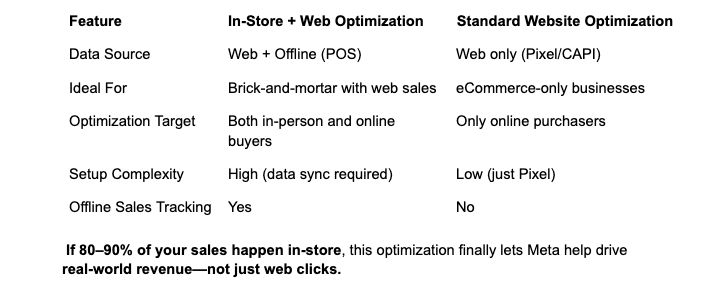Meta’s In-Store vs. Website Purchase Optimization: What Retailers Need to Know
Are you a retailer who’s always struggled with Meta ads—especially when it comes to tracking in-store purchases?
Have you wished Facebook would stop optimizing for vanity metrics and finally help you drive real, in-store sales?
You’re not alone—and now, you might finally have a solution.
Meta has quietly launched a major update: You can now optimize your ad campaigns for both website and in-store purchases.
This is a game-changer for brick-and-mortar retailers. For the first time ever, Meta isn’t just focused on clicks and conversions that happen online—it’s now helping drive foot traffic and offline sales too.
In this article, we’ll break down exactly how this works, what you need to qualify, and whether this new optimization is the right move for your business.
What Is Meta’s New Website + In-Store Optimization?
This new optimization type inside Meta Ads Manager allows advertisers to optimize for both website purchases and in-store sales simultaneously.
Previously, Facebook campaigns only allowed optimization based on digital interactions—think: website conversions, leads, video views, or post engagement.
Now, retailers can train Meta’s algorithm to find people more likely to buy in person, not just online.
How It Works Inside Meta Ads Manager
Here’s how to activate this new optimization:
Go to Meta Ads Manager and create a new campaign
Select “Sales” as your campaign objective
At the Ad Set level, choose “Website and In-Store” under Conversion Location
Pro Tip: You’ll need to send both online and offline conversion data back to Meta in order to unlock this option. More on that below.
What You Need to Qualify (Offline Data Score & Setup)
To use this hybrid optimization, Meta requires two things:
1. Two Active Datasets
One dataset for web events (formerly the “Pixel”), tracking eCommerce behavior
One dataset for offline events, connected to your POS or CRM system
2. A High Offline Data Quality Score
Meta uses a score between 1–10 to rate the accuracy and completeness of your offline data
You’ll need a score of 8.5 or higher to activate in-store optimization
This score improves when you upload details like:
Full name
Email address
Phone number
Purchase date
Purchase amount
If you’ve never uploaded offline data before, this option will not appear in your ad account.
How to Send Offline Purchase Data to Meta
You have two options:
1. Use Omni Lightning (Recommended)
A tool like Omni Lightning connects directly to your POS system and automatically pushes offline transactions to Meta in real time. This ensures ongoing sync and a high data score.
2. Manual CSV Uploads
If you’re doing this manually, you’ll need to regularly upload a CSV file with columns for:
Name
Email
Phone number
Transaction date
Amount
Manual uploads are more error-prone and time-consuming—but they can work if you’re just getting started.
In-Store + Web Optimization vs. Standard Website Conversion Optimization
Who Should and Shouldn’t Use This Optimization
This Is For:
Local or regional retailers with brick-and-mortar locations
Businesses that generate 50%+ of sales in-store
Companies that want to track the ROI of Meta ads beyond eCommerce
This Is NOT For:
Purely online retailers
Service-based businesses
B2B brands without walk-in foot traffic
Our Real-World Results (So Far)
We’ve tested this new setup with a few clients—and while it's not available to everyone yet, here’s what we’ve learned:
You need to upload at least 100 offline purchases
Your data score must be high (8.5+)
When set up correctly, Meta’s targeting improves significantly, helping drive more in-store visits and measurable sales
If you haven’t been uploading offline purchase data, Meta will not unlock this feature in your account.
Final Takeaway: Is Meta’s In-Store Optimization Worth It?
Absolutely—if you’re a physical retailer with a hybrid sales model.
For too long, Meta left brick-and-mortar businesses behind. Now, with this update, you can finally stop optimizing for vanity metrics and start driving (and tracking) real results.
Next Step: Want to Know If You Qualify?
At Omni Digital Group, we help retailers integrate their POS systems with Meta and unlock the full power of this new optimization strategy.
Stop wasting ad dollars on clicks you can’t tie to sales.
Schedule a free demo today to learn how to make Meta work for your store—online and off.
Visit www.omnidigitalgroup.com and click “Schedule a Call” to get started.
